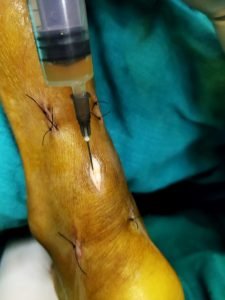Platelet Rich Plasma (PRP) therapy is relatively a novel treatment designed to aid in the healing and regeneration of soft tissues such as tendons and ligaments. While evidence suggests that platelet-rich plasma (PRP) promotes tendon cell regeneration, scientists do not completely understand how or under what circumstances.
Medical professionals describe tendon degeneration as tendinosis or tendinopathy. Tendons and ligaments are made up of fibers of collagen. When these fibers are stretched or torn we may refer to the injury as a “pull”, “tear”, “sprain” (ligament) or “strain” (tendon). When they are injured they bleed. Enough bleeding may cause bruising around the area of injury. Blood flow to the area increases to aid in healing. The blood carries platelets and growth factors that allow for healing of the tissue by creating new collagen fibers. These new fibers need to be constructed in an organized, layered fashion to heal correctly and allow the ligament or tendon to regain its proper strength and flexibility.
On few occasions, the healing process does not work correctly and instead of forming healthy collagen fibers there is significant scar tissue may develop in its place. The scar tissue even further prohibits proper blood flow as new capillaries and other small blood vessels can’t penetrate through the scar tissue. The new development of small blood vessels is called “neovascularization”. When scarred or disorganized tissue inhibits this process, the blood flow to the area becomes “blocked”. This means that the tissue will never really have the opportunity to heal correctly. That is why sometimes ligament and tendon injuries heal and other times they do not.
Patients become frustrated when these injuries don’t heal. Patients may try many treatments e.g. Physical therapy, NASIADs, topical creams and gels, braces, acupuncture and cortisone injections but nothing seems to work. These forms of treatments donot treat the underlying problem of scar tissue, disordered fibers and poor angiogenesis (blood flow). Many of them end up with pain and disability and seek surgical options. But surgery to treat tendon damage and degradation, such as arthroscopic debridement, do not always work, tend to carry more risks, and have longer recovery times.
Platelets are a normal component of blood, just like red and white blood cells. Platelets release substances called growth factors and other proteins that regulate cell division, stimulate tissue regeneration, and promote healing. Platelets also help the blood to clot.
Platelet Rich Plasma (PRP) therapy is a purely natural process using the body’s own healing factors. In PRP treatment the patient’s own blood is taken and processed using specialized medical equipment to produce a therapeutic injection(s) that contains plasma with a higher concentration of platelets than is found in normal blood that are essential for tissue healing.
This small amount of fluid with concentrated platelets and growth factors is called platelet rich plasma (PRP).
The Plate Rich Plasma (PRP) can be injected directly into very small tears in tendons and ligaments which are sometimes not apparent on MRI. Once these platelets and growth factors become activated at the injured site, they recruit local cells for healing. They also recruit other healing proteins and factors to the area for regeneration of the tissue.
PRPP not only allows for healing of injuries which may not otherwise heal, but it also speeds up recovery of injuries which may eventually heal over a longer period of time.
It is unclear how PRP therapy may alleviate tendon pain in some people. Experts theorize that the PRP might:
An experienced physician should perform the injections. The use of imaging technology, such as ultrasound, may be used to ensure a safe and precise placement of the injection into the damaged tendon.
One must avoid corticosteroid medication at least 3weeks prior to the procedure. One must avoid NSAIDS or pain killers and stop taking anticoagulant therapy at least 5dyas prior to procedure.
Plasma Rich Platelet (PRP) therapy is a great option for two different patient populations. One is the patient with the chronic injury that never heals. The other is the patient with an acute injury which might otherwise take 8-12 weeks to heal and is looking to do something to “speed up” the recovery process.
Patients should keep in mind that PRP is not a cure-all, and it may be best used in combination with nonsurgical treatments and lifestyle changes, such as physical therapy, weight loss, taping, and NSAIDs. PRP has recently also been shown to be effective in treating osteoarthritis (OA). PRP may be an excellent non-invasive alternative to joint replacement surgery in treating the symptoms of arthritis.
PRP therapy can be used with great success for the following conditions:

Dr Debnath injecting PRPP in a 30year old male with chronic tendo Achilles tendinopathy who had an excellent outcome with relief of pain and disability.
| Foot and ankle: | Plantar fasciitis |
| Achilles tendonitis and partial tears | |
| Knee: | Patellar tendonitis and tears |
| Quadriceps tendonitis and tears | |
| Thigh: | Hamstring strains |
| Elbow: | Medial epicondylitis (golfer’s elbow) |
| Lateral epicondylitis (tennis elbow) | |
| Shoulder: | Rotator cuff tendonitis and partial tears |
